Rare Lincoln Wheat Penny: A $6.2 million Lincoln penny headline is viral clickbait; the most expensive Lincoln cent on record is the unique 1943‑D bronze (copper) cent that sold for about $1.7 million at auction, not $6.2 million. For Indian readers, the real opportunity is understanding which Lincoln cents are genuinely valuable, how to identify them, and how to avoid fakes if buying or selling from India’s growing online numismatic marketplaces.
What the $6.2M claim is
Several social posts and aggregator pages in 2025 are circulating the phrase “Rare Lincoln Penny Worth $6.2 Million,” usually tied to the famous 1943 copper (bronze) error story, but without verifiable auction proofs for a $6.2M sale figure. Credible numismatic references consistently cite the all‑time record for a Lincoln cent as the 1943‑D bronze that realized around $1.7 million in 2010, not $6.2 million, making the $6.2M figure unsubstantiated.
The real record: 1943 copper errors
In 1943, the US Mint switched cents from copper to zinc‑coated steel for the war effort; a few leftover copper planchets were accidentally struck, creating the ultra‑rare 1943 bronze cents across mints (P, D, S). Only one 1943‑D bronze cent is confirmed and it set the Lincoln cent price record at roughly $1.7 million; other 1943 bronze cents typically range from six figures to low seven figures depending on condition and provenance.
How to identify genuine 1943 copper cents
- Weight and magnet test: genuine 1943 copper cents weigh about 3.11 g and are non‑magnetic; common 1943 steel cents weigh ~2.7 g and stick to a magnet.
- Authentication: certification by PCGS or NGC is essential because copper‑plated steel and altered‑date fakes are widespread in this niche.
- Rarity reality: total known 1943 bronze population is only in the dozens across all mints, so any raw “find” should be treated skeptically until graded.
Common fakes and pitfalls
Copper‑plated 1943 steel cents and altered dates (e.g., 1945 or 1948 reshaped to resemble a “3”) are the most frequent counterfeits; most “attic discoveries” fail basic tests or grading scrutiny, so third‑party verification is non‑negotiable before any high‑value transaction. Public auction records and grading‑service databases are the best benchmarks for real market values, not social headlines or private listings claiming millions.
Guidance for Indian buyers and sellers
- Verify with top graders: insist on PCGS/NGC slabs for any 1943 copper claim; avoid paying premium prices for uncertified pieces offered on social platforms or classifieds.
- Price expectations: authentic 1943 bronze cents in typical grades trade from ₹80 lakh–₹15 crore equivalent ranges based on recent USD results, but no verified Lincoln cent has achieved anything close to ₹50+ crore implied by $6.2M claims.
- Due diligence: reference major US auction houses’ archives to cross‑check any claimed pedigree or sale history before import, and budget for customs and authentication logistics if buying from abroad.
Bottom line
The “$6.2 million Lincoln penny” is not supported by verifiable auction data; the benchmark remains the 1943‑D bronze at about $1.7 million, with other 1943 copper examples trading lower based on grade and rarity. For Indian collectors, focus on authentication, magnetic/weight tests, and established auction records to separate genuine six‑ or seven‑figure rarities from viral myths and common fakes.
